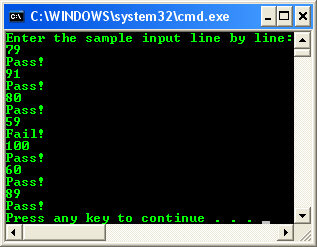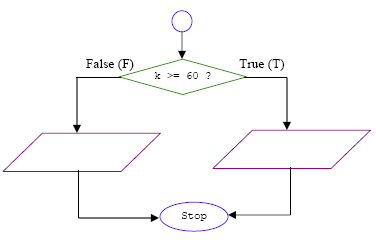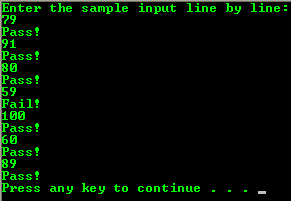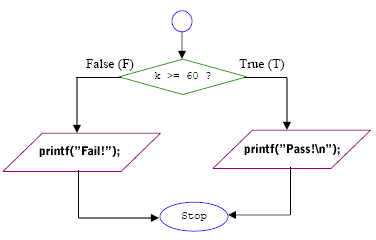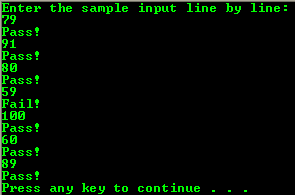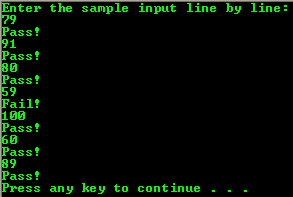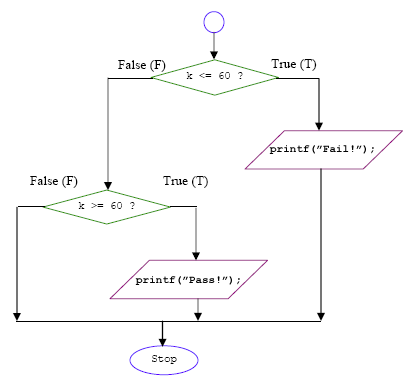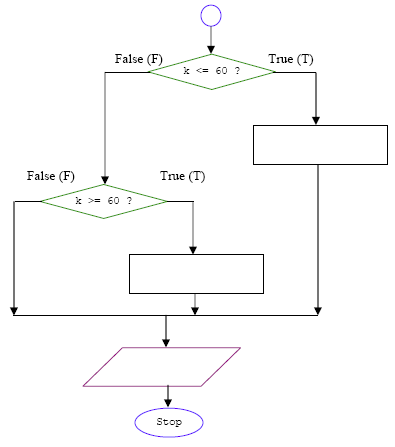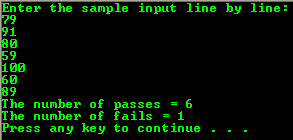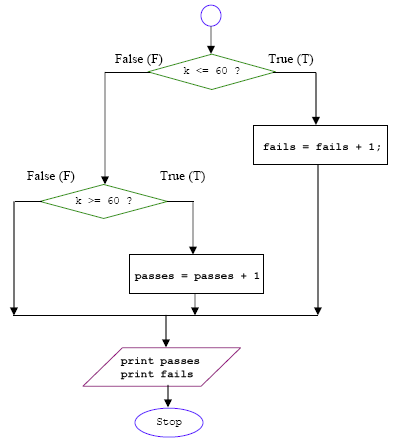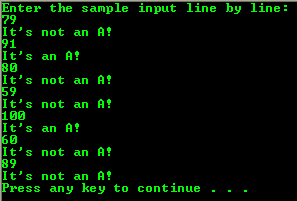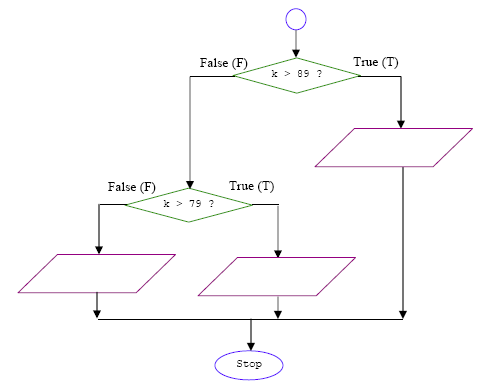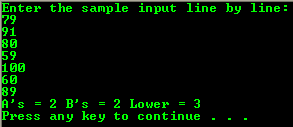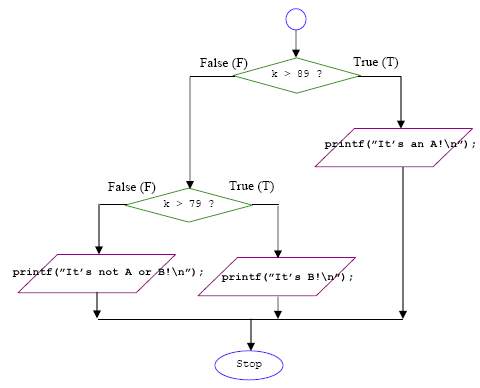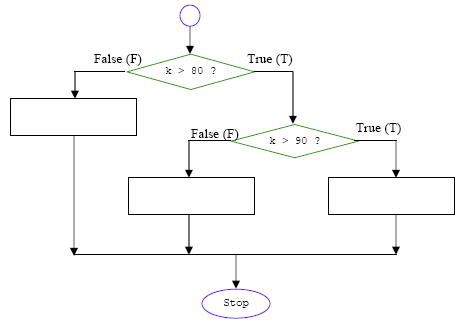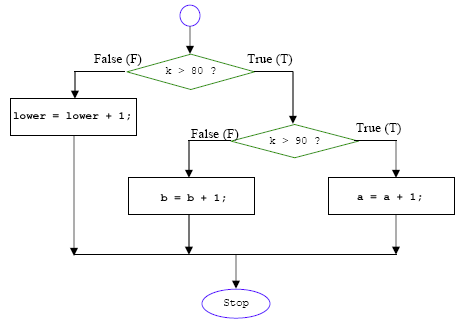| Main |<C & C++ if and if-else 1 |C & C++ if and if-else 3 >|Site Index |Download |
C LAB WORKSHEET 8_1
C & C++ Selection: if, if-else, if-else-if Part 2
Items in this page:
The if,if-else construct and the variations.
Activities, questions and answers.
Tutorial reference that should be used together with this worksheet are:C & C++ program control 1 and C & C++ program control 2.
More Examples And Practices
79 91 80 59 100 60 89 45 90 |
| ||||||||||||||
#include<stdio.h>
int main(void) { int i, k; printf("Enter the sample input line by line:\n"); for(i = 1; i <= 7; i = i + 1) { scanf_s("%d", &k, 1); if(k < 60) printf("Fail!\n"); else printf("Pass!\n"); } return 0; }
| A sample input and output.
| ||||||||||||||
| |||||||||||||||
#include<stdio.h>
int main(void) { int i, k; printf("Enter the sample input line by line:\n"); for(i = 1; i <= 7; i = i + 1) { scanf_s("%d", &k, 1); if(k>= 60) __________________________ else __________________________ } return 0; }
Note: The small circle means a continuation from other part of the full flowchart.
| if(k >= 60) printf("Pass!\n"); else printf("Fail!\n");
| ||||||||||||||
| |||||||||||||||
#include<stdio.h>
int main(void) { int i, k; printf("Enter the sample input line by line:\n"); for(i = 1; i <= 7; i = i + 1) { scanf_s("%d", &k, 1); if(k >= 60) _____________________________ if(k < 60) _____________________________ } return 0; } | if(k >= 60) printf("Pass!\n"); if(k < 60) printf("Fail!\n");
| ||||||||||||||
#include<stdio.h>
int main(void) { int i, k; printf("Enter the sample input line by line:\n"); for(i = 1; i <= 7; i = i + 1) { scanf_s("%d", &k, 1); if(k<= 59) _____________________________ if(k>= 60) _____________________________ } return 0; }
| if(k<= 59) printf("Fail!\n"); if(k>= 60) printf("Pass!\n");
| ||||||||||||||
#include<stdio.h>
int main(void) { int i, k, passes = 0, fails = 0; printf("Enter the sample input line by line:\n"); for(i = 1; i <= 7; i = i + 1) { scanf_s("%d", &k, 1); if(k <= 59) _____________________________ if(k >= 60) _____________________________ } printf("The number of passes = %d\n", passes); printf("The number of fails = %d\n", fails); return 0; }
| if(k <= 59) fails = fails + 1; if(k >= 60) passes = passes + 1;
| ||||||||||||||
| |||||||||||||||
#include<stdio.h>
int main(void) { int i, k; printf("Enter the sample input line by line:\n"); for(i = 1; i <= 7; i = i + 1) { scanf_s("%d", &k, 1); if(k_____________) printf("It's an A!\n"); if(k ____________) printf("It's not an A!\n"); } return 0; }
|
| ||||||||||||||
#include<stdio.h>
int main(void) { int i, k; printf("Enter the sample input line by line:\n"); for(i = 1; i <= 7; i = i + 1) { scanf_s("%d", &k, 1); if(k > 89) // only A's printf("It's an A!\n"); elseif (k > 79) // non A's, only B's printf("It's B!\n"); else // others printf("It's not an A or B!\n"); } return 0; }
|
------------------------------------------------------------------ -----------------------------------------------------------------
| ||||||||||||||
lower = lower + 1;a = a + 1; and b = b + 1;
#include<stdio.h>
int main(void) { int i, k, a = 0, b = 0, lower = 0; printf("Enter the sample input line by line:\n"); for(i = 1; i <= 7; i = i + 1) { scanf_s("%d", &k, 1); if(k >= 80) if(k >= 90) ________________________________ else ________________________________ else ____________________________________ } printf("A's = %d\tB's = %d\tLower = %d\n", a, b, lower); return 0; }
| if(k >= 80) if(k >= 90) a = a + 1; else b = b + 1; else lower = lower + 1;
| ||||||||||||||
| Main |<C & C++ if and if-else 1 |C & C++ if and if-else 3 >|Site Index |Download |
The C Selection if, if-else, if-else-if, break, conditional/ternary operator and switch-case-break:Part 1 |Part 2 |Part 3 |Part 4 |Part 5 |Part 6
